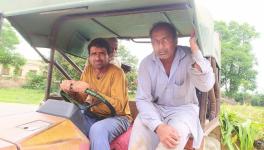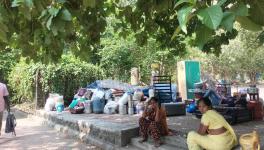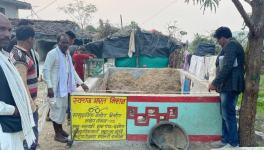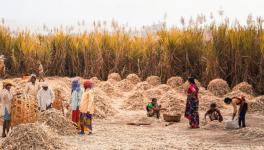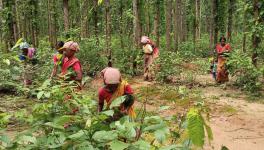COVID-19 in Rural India-XII: Unable to Harvest, Latur Farmers Forced to Let Standing Crop Rot

Representational image. | Image Courtesy: Deccan Herald
This is the 12th report in a series that provides glimpses into the impact of COVID-19-related policies on life in rural India. The series, commissioned by the Society for Social and Economic Research, comprises reports by various scholars who have been conducting village studies in different parts of India. The reports have been prepared on the basis of telephonic interviews with key informants in their study villages. This report describes the impact of the COVID-19 pandemic and the nationwide lockdown on the lives and livelihoods of the inhabitants in two villages in Latur district in Maharashtra’s Marathwada who are facing loss of work. Several farmers are staring at huge losses as they are unable to harvest their standing crop, which is wilting in the summer heat.
Laturwadi and Wazgaon (names changed) are two villages in Latur district of Marathwada division in Maharashtra. These villages lie in a predominantly agrarian block with no industrial or urban centre. Accordingly, the primary source of livelihood in both these villages is agriculture.
Laturwadi is a small village with a population of 1,500 to 1,700. It is 14 km away from the nearest highway with poor transport and phone connectivity even on a good day. In contrast, Wazgaon is a big and politically-prominent village with a population of 7,000 to 8,000 and is five km away from the nearest highway. Laturwadi and Wazgaon are separated from each other by more than 35 km. While Latur district is known for facing acute water scarcity due to frequent droughts, this block is only very slightly better off in this regard. There are no public sources of irrigation such as dams (small or big) but there are some ponds and private forms of irrigation, such as bore-wells and traditional wells on individual farms.
These villages see significant out-migration to Mumbai, Pune and other urban centres in Maharashtra for employment. They are concentrated in the informal sector, in small private enterprises, as daily wage labour and, to a much smaller extent, in the platform economy. A significant proportion of these migrants returned to the villages in the week preceding the lockdown due to the state-wide closing of schools, colleges and offices. Three days before the March 22 Janata Curfew, on March 19, all ASHA and Anganwadi workers in the block were mandated to attend a workshop on COVID-19, where they were educated on the symptoms of the disease and necessary precautions to be taken. They were asked to survey all households to identify migrants who had just returned to the village.
Their reports were then forwarded to the Primary Health Centre, which sent a doctor to examine the migrants for symptoms. Further, the ASHA and Anganwadi workers were to monitor the migrants for symptoms for at least two weeks from the date of their return to the village. These predominantly female frontline care-workers facilitate the doorstep delivery of essential public welfare services in rural areas in addition to whatever else is asked of them by the state, including helping to monitor the spread of COVID-19. They continue to await the release of the hike in their salaries announced in October 2018, while also frequently facing delays (sometimes by months) in the payment of their wages. Latur has still not recorded any cases of COVID-19 with the exception of eight travellers from Andhra Pradesh, who were passing through the district and are currently undergoing treatment.
Laturwadi
This village has about 200–300 households, and the average landowning household has about eight to ten acres. There are very few big farmers, and the highest land holding even among them is about 20-22 acres per nuclear household. The last kharif crop yield was extremely poor on account of the area having received little to no rainfall in the monsoon, as has been the case for the last five years in Marathwada. However, the rabi crop was bountiful due to showers in the period between late September and November. Farmers sowed soya bean (a cash crop), otherwise a kharif yield, in September, which was then harvested by December. However, by early January, the prices of soya bean had begun to fall with the advent of COVID-19 in China, one of the major buyers of the product. As a result, most soya bean stocks remain unsold, as farmers hope the prices will increase.
The rabi season saw the cultivation of subsistence crops such as jondhale (a traditional variety of jowar, the staple grain in these areas), wheat (by a small section of farmers), and harbhare (aka chickpea or chana dal). Unseasonal rain and harsh winds in late February had already caused some damage to the crops in this area, for which farmers were in the process of demanding crop compensation from the state. These crops had just begun to be harvested when the COVID-19 lockdown was announced in India. However, harvesting continued under lockdown and threshing is presently nearing completion. A significant portion of this harvest is kept aside for household consumption, while about one-third to one-fifth is given to workers as wages in kind for guarding the crop (jowar) or harvesting and threshing (chickpeas). The remainder that is meant to be sold will have to wait until the markets reopen. This is in addition to the unsold soya bean stocks.
Further, a small section of farmers with assured irrigation in their fields (in whatever form) have sown a third (summer) crop mostly comprising vegetables and some fruits, including string beans, okra, tomato, cucumber, and melons. However, this crop cannot be harvested owing to the lack of buyers and lack of access to agricultural produce markets. One of the relatively big farmers who had cultivated cucumber on his farm hired a truck from within the village, loaded the produce using village labour, and managed to transport it to the market town seven km away. However, the police turned the truck back to the village and the entire produce was dumped on one of the roads leading to the village. The rest of the summer crops have been left standing in fields, where they are wilting and rotting in the extreme summer heat of Marathwada. Most farmers have deployed their entire families (to save labour costs) to clear their fields in preparation for the next crop cycle. One farmer who had cultivated vegetables on two acres of his ten-acre farm has estimated a loss of Rs 20-25,000 in investment and nearly Rs 50,000 in profits, essential for financing the kharif crop.
Unsold stocks from the previous kharif and rabi seasons as well as losses incurred on the summer crop will impact the upcoming kharif season even before the rains have had a chance to play spoilsport. These setbacks will firstly impact the liquidity of farmers, which will affect field preparation, purchase of inputs, and payments to labour. The distress sale of crops as soon as markets reopen may not necessarily fetch farmers competitive prices even as consumers will have to pay higher prices for food products. Most farms will now lie fallow until the monsoons arrive. The lockdown has also caused a lag in the repair of farm implements and machines, as mechanical parts and technicians are unavailable. Further, depending on when markets reopen and supply chain regains full functionality, farm inputs too maybe in short supply for kharif. All of this is, of course, separate from the outstanding debt that farmers have accrued due to repetitive droughts and crop failure in the larger Marathwada region apart from the government’s implementation of demonetisation and the goods and services tax, which have also taken a toll on the agricultural economy in the last five years.
Most marginal landholders and landless labourers (comprising nearly 35% to 40% of the village) in Laturwadi have managed to work through March, some even up to mid-April, due to the continuing availability of farm work. However, skilled labourers among these, mostly dalit and other lower caste male labourers who normally work in construction, masonry, digging, painting, driving and so on, are all out of work and at home. One unexpected source of relief is that farm workers have been able to gather vegetables and fruits from the now-abandoned summer crop for free. But this will last only for a short period due to the low shelf life of the produce. The state government of Maharashtra on April 11, announced the extension of the lockdown until the end of April. Most of these households are staring at dire straits if economic activity does not resume soon.
There is no MGNREGA work available in the village, and construction under government housing schemes in the village has also come to a standstill due to the disrupted supply of building material. Among the measures introduced by the state for the poor are the direct transfer of Rs 500 into all Jan Dhan accounts, and free cooking gas cylinders for a period of three months for beneficiaries under the Pradhan Mantri Ujjwala Yojana. Even as the food security of labourers in the village is uncertain, migrants continue to return to the village through a combination of walking, hitching rides on motorcycles, hiding in trucks carrying essential produce, etc.
This village is connected to the block town (15-17 km away) by a single lifeline, the state transport bus service, which makes two rounds of the village in the morning and evening. During the lockdown, all ST services have been discontinued, so people have to rely on private transport, predominantly two-wheelers. However, petrol is in short supply locally. The market town is seven km away and its opening times are limited to 11 a.m. to 2 p.m. On the day of the Janata Curfew, all the addas (places where groups of people gather) and drains in the village were sprayed with disinfectant. The provision of milk and rations continues as before. The nearest ATM is in the market town, and banking facilities are in the block town. The police makes rounds of the village every alternate day. However, surveillance is not very strict here thanks to the lack of much movement to and from the village, size of population and scale of agricultural operations here.
Wazgaon
This is an agriculturally prosperous and high-profile village. It has a number of big farmers with nearly 100–200 acres of land. The major crop here is tomato, with the village being a major wholesale supply point for tomato in the block. About 10 to 15 traders hire 200-250 Bihari migrant labourers round the year for loading and unloading produce. The current tomato crop has been entirely wasted as no sales are happening. Tomato cultivators have all faced losses of up to 1.5-2 lakhs each. This village also sees a lot of horticultural cultivation (fruits and vegetables) given its proximity to the block as well as district markets and a relatively wider spread of private irrigation facilities.
The size and prominence of the village, however, has resulted in continuous and strict police surveillance. They make two rounds every day and beat anyone seen out on the streets. This has resulted in the complete stoppage of all economic activity in the village. Subsistence crops such as jowar and chickpea are ready for harvest but the police is not allowing workers to go to work. Apart from farmers, this has especially created a crisis for farm workers within (and in neighbouring villages) as there is no work and therefore no income. Yet, the big landlords are unwilling to provide any relief to workers by way of free rations or community kitchens. No MGNREGA or government housing scheme work is underway. There is an ATM in the village, but it has not been replenished since it ran out of cash. Jan Dhan account holders here, too, have received Rs 500 in their accounts, but in the Ujjwala scheme, middlemen have been extracting money from beneficiaries for availing the concessions therein. While PDS rations were supplied as usual last month with no concessions in prices or quantities, the supply of milk has stopped. The health sub-centre is running as usual.
Regarding the Bihari in-migrants, the talathi (village revenue official) sent a letter to the village panchayat asking the workers to leave. The workers did leave as soon as the lockdown was announced but returned due to lack of transport. Some of the dalit leaders in the village who tried to intervene before the works left, wrote to the district collector on their return requesting transportation for the workers. The collector then directed the panchayat to provide cooked meals to the workers. While the panchayat is yet to fulfil this direction, it has in the meanwhile agreed to allow the workers to remain at their workplace, that is, the tomato loading points, on the outskirts of the village. These workers have had to manage cooking and eating on their own. Most daily wage workers in the village as well as the Bihari in-migrants have been surviving by buying from shops on credit and picking vegetables from farms, if at all, both of which methods are unsustainable beyond a week or two.
The author is a Commonwealth doctoral scholar at the University of Edinburgh, UK. She has been conducting an ethnographic study in the above area since December 2019.
Get the latest reports & analysis with people's perspective on Protests, movements & deep analytical videos, discussions of the current affairs in your Telegram app. Subscribe to NewsClick's Telegram channel & get Real-Time updates on stories, as they get published on our website.










